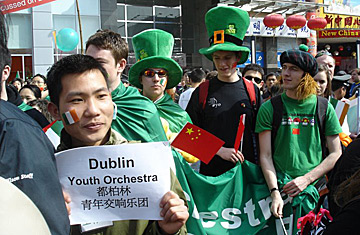
Beijing's first-ever Saint Patrick's Day parade.
"I see a lot of mystification in the eyes of locals," said Dick Roach, as the parade trooped near Beijing's forbidden city. Parades in China's capital are a regular occurrence, of course, often massive affairs led by schoolchildren, soldiers, and other friends of the state. But the wide-eyed stares to which the Republic of Ireland's EU minister was referring were prompted by the city's first-ever Saint Patrick's Day parade. "People in Ireland are curious about people in China," said Roach, who helped lead the procession."And people in China are curious about people in Ireland."
Organized by the Irish embassy in conjunction with the local Dongcheng District government, the parade was small but significant. Doubling back twice in fifteen minutes over a two-block stretch near the Forbidden City, participation was limited to 200 people due to security concerns surrounding the nearby session of the National People's Congress. Roach walked at its head, alongside Ireland's ambassador to China, Declan Kelleher; a traditional bagpiper; and County-cork born Beijing local Shane O'Neill, whose leprechaun costume purchased at a Dublin shop came complete with a false belly. The trailing marchers included members of the Dublin Youth Orchestra, the local youth Irish dance troupe "The Celtic Dragons," and the chorus from the Bai Nian Vocational School, a free school that serves the children of migrant workers and to which the Irish embassy has donated a language lab. Bedecked in green, orange, and violet, giddy participants proudly carried the flags of either country. On the apples of their cheeks, most marchers wore the three-leaf clover stickers that had been handed out by embassy employees. When Bai Nian students asked their chaperone if the stickers were of Ireland's national flower, the amused teacher could only think to explain that the shamrock is "a type of grass."
The event may be the first parade organized and led by foreigners in the Chinese capital in at least 50 years. "The idea of the parade is to reflect the warm human ties between Ireland and China," said Wang Hong Bing, the Dongcheng District Director of the Ministry of Propaganda. What was the secret to winning state approval? Says Ambassador Kelleher, "A lot of hard work and a lot of assurances." Adds Minister Roach, "Ireland is a very, very small country. No one sees it as a threat. It doesn't have an agenda." And, of course, there had been something of a dry run, last year, in China's first ever St. Patrick's Day Parade, held in Shanghai, a city traditionally more open to foreigners.
The Beijing parade may also be a reflection of the capital's awareness of its responsibilities as this year's Olympic host. "With the games this year," said Ashley Hong, a college student watching the festivities in a green tinsel necklace "everyone here is excited to welcome people from all over the world. And we don't have too many parades."
On both sides of the central stage set up before the Wang Shi Bai Huo department store, Tourism Ireland photo displays showcased Irish monuments, Irish people, and Irish ales. Employees handed out pamphlets on study-abroad and travel. Women in fitted and fringed orange sportsuits handed out samples of Bailey's toffee liqueur. Nearly blocking a speaker at the front of the stage, an eight-foot tall poster advertised cheap flights between the two capitals. Tourism Ireland has since 1995 been promoting St. Patrick's Day parades in cities around the world such as Tokyo, Singapore and Moscow. This year two cities were added to the roster: Beijing, and the digital world of "Second Life," which hosted a "virtual parade."
The religious holiday's first parade occurred in 1762 in New York, when Irish soldiers conscripted by the British army marched to bond over their shared and distant homeland. Ever since, the event has been more popular abroad than at home — though Dublin's days of revelry is no poor showing — with especially large festivals in Boston and Chicago. "The parade is a celebration of diaspora," Roach said. With hundreds of Irish nationals living in Beijing and over 50,000 Chinese emigrants composing the largest non-European community living in Ireland, the holiday has morphed into a celebration of heritage across borders. Patrick, sainted for ridding the isle of its snakes among other feats of faith, was himself an emigrant to Ireland from Roman Britain.
Beijing resident Richard Robinson, an American and a "plastic patty" — the bearer of an Irish passport thanks to an Irish grandfather — wore a cocked neon-green velvet top hat to complete his leprechaun outfit. Surveying the scene, he said, "This is the same as a parade anywhere else. Except it's more sober. And it's in China." David Sheridan, who had flown in along with his band, the Geantra Players for which he plays the fiddle, thought the event showed a needed "bit of looseness in China." He liked something about the look of it. "There's great color here," he said. "It's the green. Usually in China there's moremore red."
